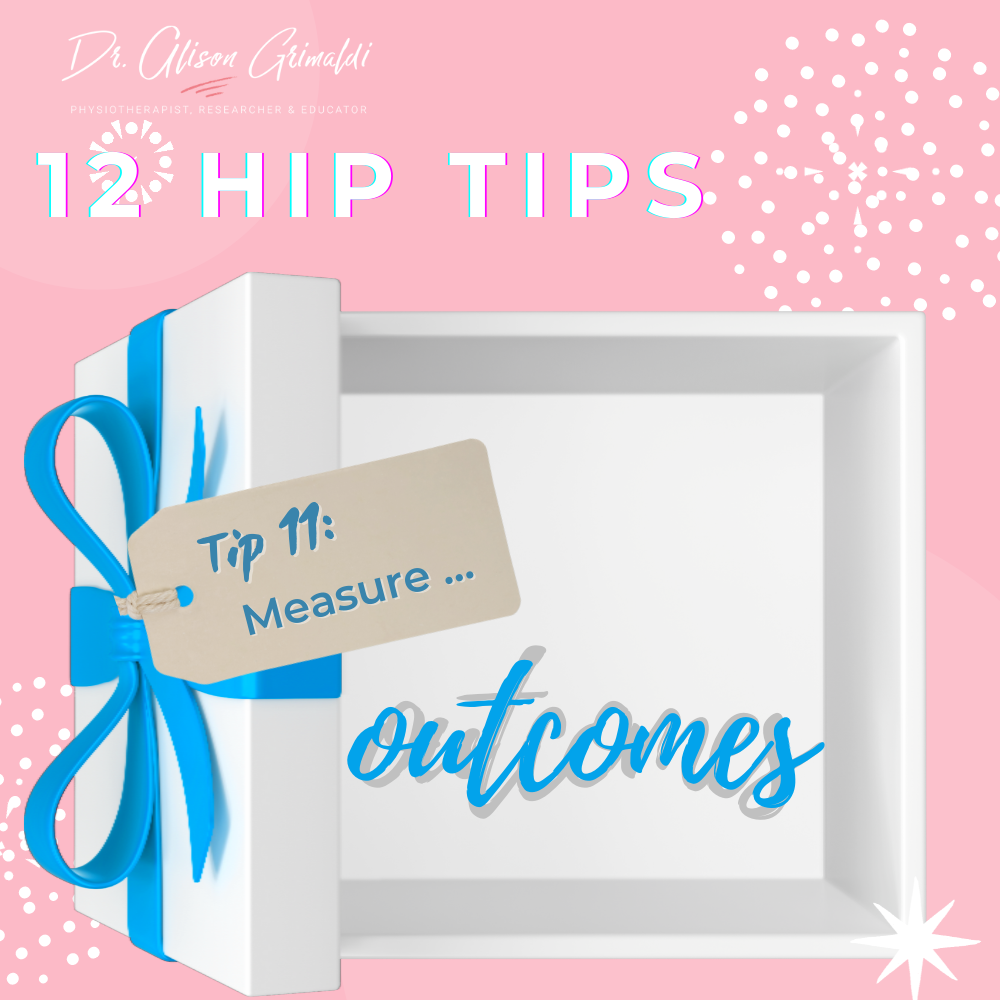Hip Tip 11 – Measuring outcomes of hip pain management

Day 11: We're almost done. The 11th of 12 Hip Tips today. Yesterday we discussed the importance of setting goals. Measuring progress towards your shared goals is the next logical step. You will have very patient-specific goals that can be measured, but it is also recommended that you employ some form of standardised outcome measure. If you've missed any of the previous hip tips, you can visit the blog listing page here.
Tip #11 Measure Outcomes
High-quality standardised measures allow us to compare outcomes not only across time for an individual but benchmark important features of health against others. Naturally this is critical for research studies, and the consistent use of similar measures in studies of the same condition allow pooling of data for meta-analyses. Using a set of standardised measures in clinical practice also needs to become the rule, rather than the exception. But time is short and there are just so many measures, it can be difficult for clinicians to determine what key features they should be measuring and how. Today, we'll look at a great framework for measuring outcomes and some tools specific for measuring outcomes of treatment of hip and groin pain.

Earlier this year (2020) a group of tendon experts from around the world, headed up by Professor Bill Vicenzino, published a consensus paper that aimed to define the core health-related domains for outcome measures used in interventions for tendinopathy1. They agreed on nine core health-related domains for tendinopathy (CORE DOMAINS), areas of measurement considered most important to track.
Outcome Measurement Core Domains
While the Core Domains paper1 is specifically targeted at tendinopathy, it provides a great framework for considering outcome measures more widely in other musculoskeletal conditions. Let's explore these core domains and what types of measures you might be able to use in clinical practice.
1.Patient overall rating of condition
This domain covers scoring systems that gather a single numerical value that reflects the patient's overall rating of the condition for which you have been treating them. It provides a global rating of how the patient is now, compared to prior to beginning treatment. The one I use clinically in this domain is the 'GROC.'
Global Rating of Change Score.
Question: With respect to the condition for which you are being treated, how would you describe yourself now compared to when you first began your treatment?
Answers: Range from very much worse to very much better.
There are different variations, some 7 point and some 11 point scales. Choose the one you are going to use and stick with it consistently. We use the 7-point scale in clinic. It's easily understood and administered. We have the scale printed and laminated in each of our treatment rooms, so the patient can visualise the options and quickly verbalise a response. In a research environment it would not be ideal to collect responses in front of the treating therapist, but in clinic when comparing that individual's responses over time, it's a quick and useful measure.
2. Pain over a specified time
Pain over a specific time is self-explanatory and something we all use in clinical practice on a daily basis. But the way the question is asked needs to be standardised and the time-frame specified, otherwise you're likely to collect inconsistent responses. For example if you ask about pain today, over the last week or over the last 2 weeks, the response is likely to be different. And do you ask about 'worst pain', 'usual pain', 'average pain' or something else ? Again these differing adjectives will return different responses. Make a choice and stay consistent.
There is also more than one important facet of pain. While pain intensity is the usual metric, I find a rating of pain constancy extremely useful. How often have you had a patient report that their pain is just the same, but on further questioning it becomes clear that while the intensity of that pain is similar, the amount of time they are experiencing that pain has substantially reduced. Well worth rating and reflecting that progress to the patient.
3. Pain on loading
Pain on loading is a useful metric, particularly for tendinopathy. It may not be as useful for conditions in which you can't reproduce pain immediately on physical loading. However, where you can standardise a physical action that reproduces pain, this can be a great way to measure progress over time. For Achilles and patellar tendinopathy, these might be actions such as a calf raise or decline squat. The patient rates pain intensity experienced during this action.
As yet, there are no standardised measures in this domain for tendinopathies around the hip and pelvis. For gluteal tendinopathy, measuring pain during the sustained single leg stance test is useful - you'll be doing this anyway in your diagnostic assessment, won't you? (read further here about diagnosing gluteal tendinopathy) You could also use something more demanding like a step-up (standardise step height and upper limb support) or collect pain during an abductor muscle strength test.
You could apply similar principles for any condition in which you can evoke immediate pain. For a joint condition it might be pain on a squat (standardise depth) or something more dynamic like hopping.
4. Physical function capacity
The physical function capacity domain includes quantitative measures of physical tasks performed in clinic. This is another domain very familiar to clinicians. Depending on the patient and the condition, you might want to measure different aspects of this domain such as strength, endurance, power, speed and dynamic balance. Some examples of tests included in this domain:
- hop distance (forward, medial, lateral),
- the 6 minute walk test (distance walked over that time),
- 5-times sit-to-stand (timed),
- a timed stair climb,
- single leg rise test (number of single leg rises from a chair),
- side plank endurance,
- star excursion balance testing,
- dynamometry, and
- data collected via wearable technologies.
5. Disability
The disability domain includes patient-rated outcome measurement tools - scoring systems that usually provide a composite score of pain and disability associated with a condition.
For hip and pelvic tendinopathies, the VISA-G2 has been developed for gluteal tendinopathy and the VISA-H3 for proximal hamstring tendinopathy. A recent consensus statement for patient rated outcomes for hip joint-related pain has been published, the Zurich Consensus. It recommended the Hip and Groin Outcome Score (HAGOS) and the iHot tools for use in young and middle-aged active adults with hip-related pain4. The HAGOS is also useful for other forms of groin pain. For hip OA, the related Hip Osteoarthritis Outcome Score (HOOS) is often chosen or the WOMAC score.
6. Function
The Function Domain is another patient-rated domain but these measures are different to the disability scores as the patient rates their level of function, rather than the influence of their pain (disability).
An example of this would be a Patient Specific Functional Scale, where the patient nominates a number of meaningful functional tasks and rates their current level of function. The scale is usually between:
- 0: Unable to perform activity and
- 10: Able to perform activity at the same level as before injury or problem.
For the lower limb, the Lower Extremity Functional Scale, is also easy to understand and score.
7. Participation
The Participation Domain is another patient-rated domain where the patient rates their level of participation across various aspects of their life. This includes ratings of level of participation in sport (return to sport parameters - level, time etc), physical activity, their workplace tasks etc.
8. Psychological Factors
The Psychological Factors Domain encompasses scores of different psychological factors which are entwined in the patient's ability to progress and restore their function and quality of life. This domain includes scores that measure psychological parameters such as:
- Pain Self-Efficacy
- Pain Catastrophisation
- Kinesiophobia
- Anxiety or Depression
- Psychological Readiness for Return to Sport.
Even for those without strong psychological contributors, a score like the pain self-efficacy questionnaire can be useful to establish the level of confidence your patient has in their ability to engage in normal facets of their life. This confidence level may influence their engagement with their active rehabilitation and ultimately their outcomes.
9. Quality of Life
You will be aware of the Quality of Life scores that provide a measure of the general wellbeing of the individual. Examples of quality of life questionnaires include:
- European Quality of Life Questionnaire (various editions e.g. EQ-5D, EQ-3D)
- Australian Quality of Life (AQoL)
- Short Form Survey (SF-36)
The more recently developed Musculoskeletal Health Questionnaire (MSK-HQ) might also be considered in this domain, but with the focus on the musculoskeletal aspects of health. I haven't used this one yet in clinic, but it might be a useful tool when managing those with musculoskeletal conditions such as hip and groin pain. A recent validation study on this tool reported that the MSK-HQ was 'as good as existing pain-site specific PROMs at identifying people reporting global improvements in their MSK condition, and was better than the EQ-5D-5L.'5
These domains don't cover every outcome that could be measured, but the 'core' or most important aspects as identified by tendinopathy experts. There is no necessity of course to use an outcome measure from each domain for every patient in your clinical practice. The first 4 domains listed here will usually be the minimum and then if you have adequate systems in place, you may be able to incorporate some other patient-rated outcome measures. Some of the exercise prescription Apps, such as PhysiApp, now have capacity to record and track these patient-rated outcome measures. The challenge is getting the patient to fill them in!
My final tip here is - don't ask for too much, too often and review externally collected data at each appointment so the patient knows you are going to be tracking their responses.
Click on the box above to read Day 10 miniblog
Click on the box above to read Day 12 miniblog



